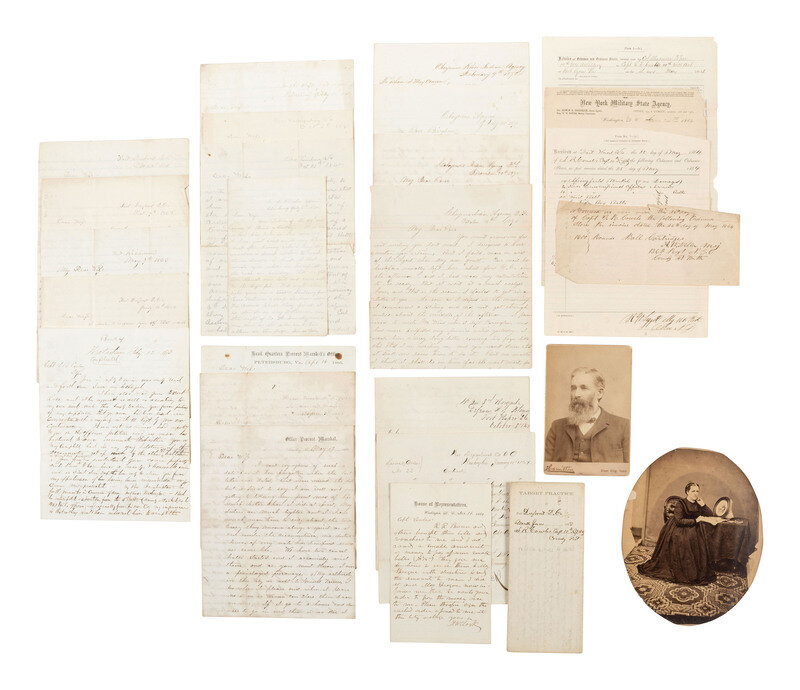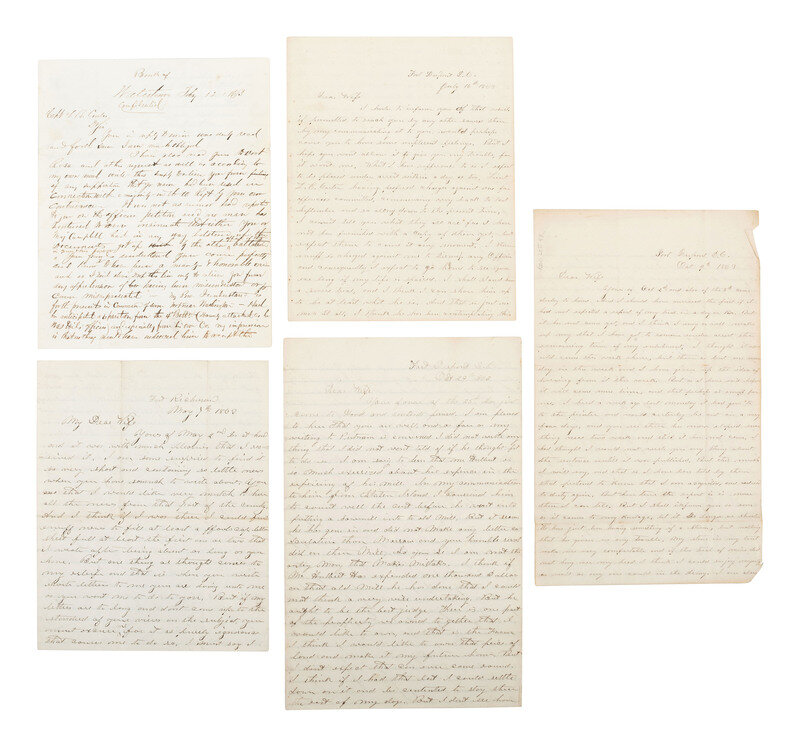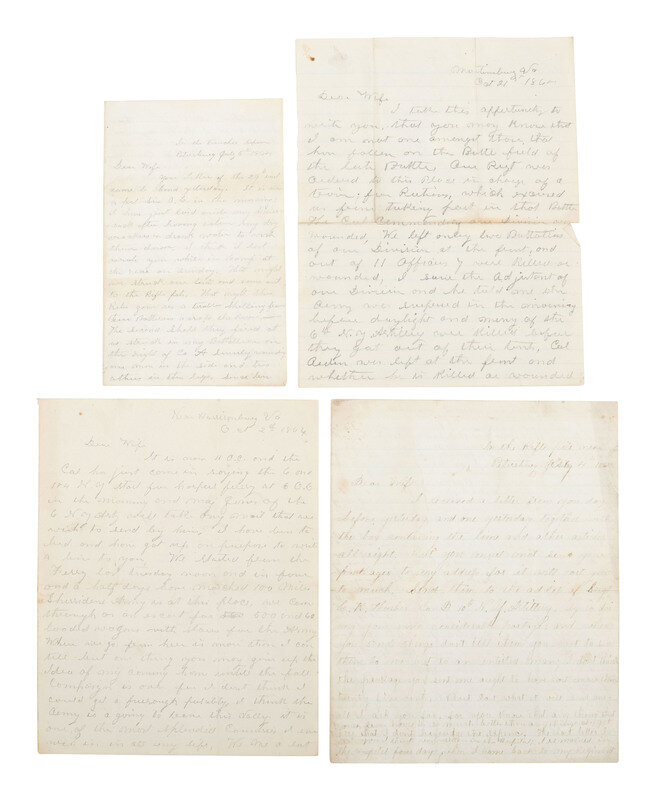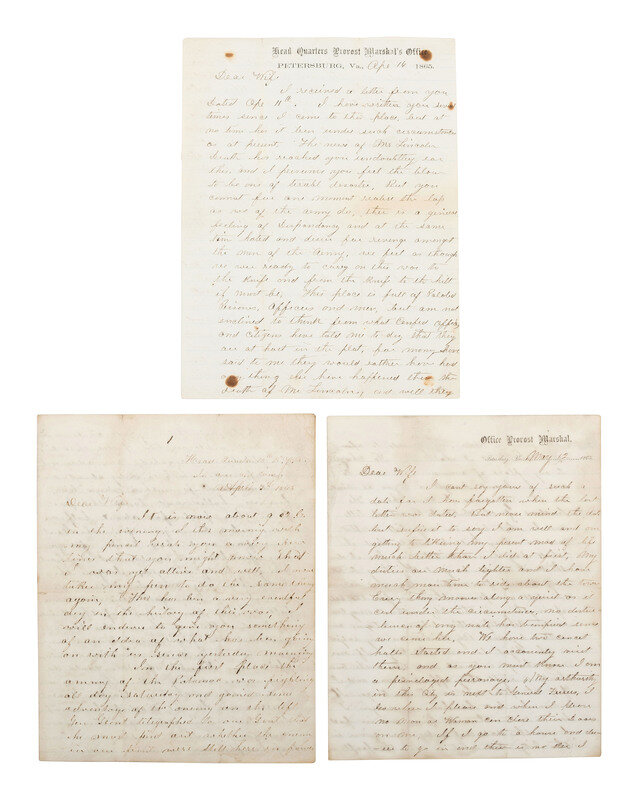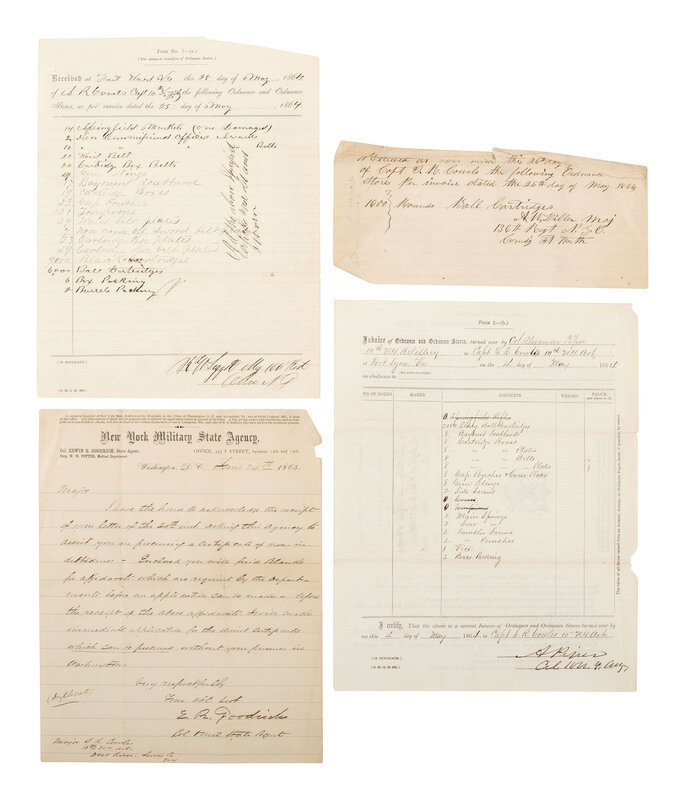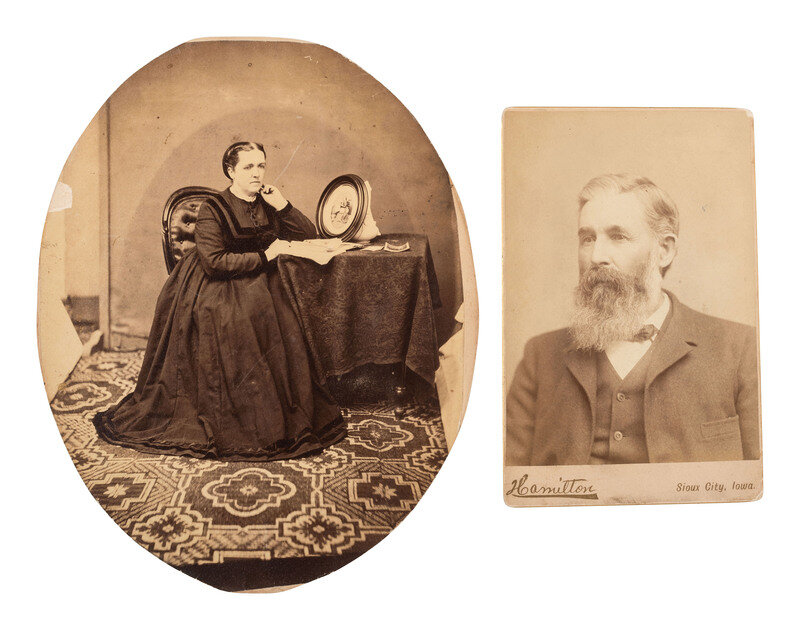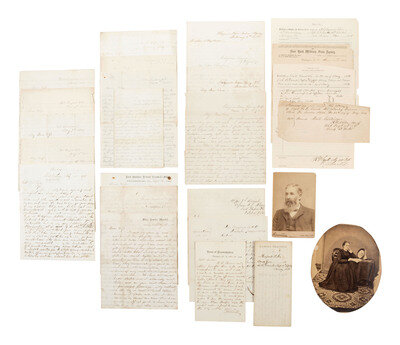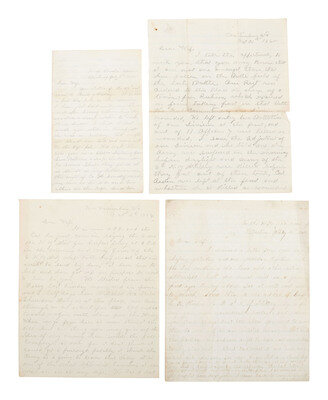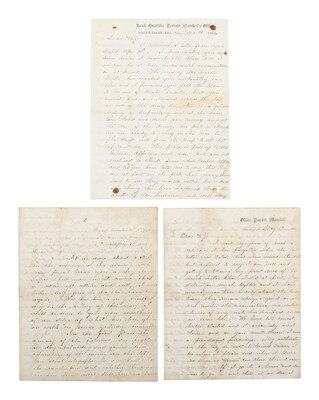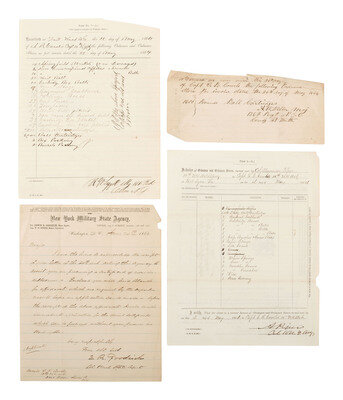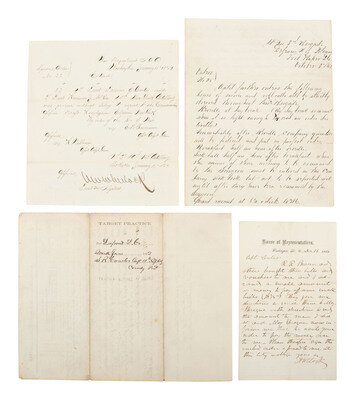[CIVIL WAR]. Papers of Major Seneca Roe Cowles (1828-1901), Co. D, 10th New York Heavy Artillery, the "Black River Artillery."
Sale 1344 - American Historical Ephemera and Photography
May 31, 2024
10:00AM ET
Live / Cincinnati
Estimate
$3,000 -
$5,000
Own a similar item?
Request An Estimate
Sold for $4,128
Sold prices are inclusive of Buyer’s Premium
Lot Description
[CIVIL WAR]. Papers of Major Seneca Roe Cowles (1828-1901), Co. D, 10th New York Heavy Artillery, the "Black River Artillery."
Group of approx. 100 letters spanning 1860 - ca 1897 (bulk 1862-1865), accompanied by approx. 20 documents most of which relate to Cowles's military service. Majority of war-date letters are written by Cowles to his wife, Elvira Johnson Cowles (1830-1902), with a small amount of correspondence constituting letters written to Seneca Cowles. Although an artillery unit, much of the 10th NY Heavy Artillery's career and all of its fighting was done as infantry. The archive spans the entirety of Cowles's enlistment including battle content from the Siege of Petersburg, the Battle of Crater, the Battle of Cedar Creek, and the Fall of Petersburg.
Two letters, dated 1860 and 1861 respectively, and both written to Cowles, constitute the earliest letters in the archive. Correspondence from 1862 (7 letters) includes 6 letters written by Cowles from "Fort Richmond," New York Harbor, as part of his initial regiment, Co. B, 4th Battalion, later to become Co. D, 10th NY Heavy Artillery. Cowles primarily discusses details of his regiment, other officers, and duties, as well as family matters. Letters from 1863 (34 letters written by Cowles) discuss similar details as in 1862, but relate in large part to controversies surrounding the appointment of officers and Cowles's hiring of cooks for the company.
Following Cowles brief move from Fort Richmond to Fort Schuyler in May 1863, he moved with his company to Fort Dupont in Washington, D.C. Shortly thereafter on 16 July 1863 Cowles writes to his wife that he expects to be placed under arrest due to charges proffered against him by the "underhanded Schoundrel [sic]" Lieutenant Lucian E. Carter, a fellow officer of Co. D. Cowles states that the charges include keeping a man in his employ to do the cooking, using the company fund, and hiring women to cook for the company and paying them out of the company fund. Cowles assures his wife of his innocence, and that he has the support of his regiment. He hires counsel, and later letters recount details of the trial and his time under arrest awaiting the results. Removed from duty, Cowles expresses increasingly embittered feelings towards Carter, as well as towards Lieutenant George B. Salter, who he believes also seeks his downfall. A letter of 29 October 1863, written while still awaiting results of his trial, describes feelings towards Carter amongst the men in the regiment. "The men many of them say if he ever goes in the field with them they will shoot him the first chance they get...." Cowles goes on to describe an incident in which Carter disciplined a man under suspicion of thievery by tying him hand and foot, gagging him, and leaving him outside in the cold until his hands turned black and blue and he could no longer speak. Details of the resolution of the trial are not recorded in the archive, however, Cowles was allowed to remain with his regiment, receiving a promotion to Major on 4/6/1864.
Correspondence from 1864 (35 letters) commences in March 1864 and includes 34 letters from Cowles. In the latter part of May 1864, the the regiment was sent to the front with the other heavy artillery commands to reinforce Gen. Grant, seeing action for the first time at Cold Harbor (though this correspondence does not describe that conflict). Cowles writes in detail about preparations for the field, troop movements, and his fellow soldiers. Though Cowles was ill and in the hospital for portions of 1864, his 1864 letters are particularly strong with regard to details of service and engagement in the rifle pits before Petersburg. A letter of 4 August describes the mine explosion associated with the Battle of Crater: "it is true we blew up a Rebel Fort, but nothing further was gained...I think from one to two hundred pieces of artillery were discharged at the same time...played for about an hour when it lulled, then came the charge from our troops...." In August the regiment was removed from the front and ordered to the Shenandoah Valley to participate in Sheridan's Shenandoah Valley Campaign. Cowles describes orders to burn barns that had grain, take cattle, sheep, and hogs, and prevent any provisions from getting to Confederates. The regiment participated in the Battle of Cedar Creek, writing in part: "the army was surprised in the morning before daylight and many of the 6th NY Artillery were killed before they got out of their tents....The Rebs drove our whole Army in confusion about 3 miles when we halted until Gen Sheridan came up and charged the Rebs and drove them 10 or 15 miles...."
By 1865 (15 letters all from Cowles) the 10th NY has moved to Bermuda Hundred and later would participate in the final assault on Petersburg on 2 April 1865 as part of the Appomattox Campaign. A detailed letter from 3 April 1865 describes how Cowles participated in an advance on the Confederate works (writing in 3rd person): "Major Cowles was ordered with the 2nd Battalion to assault their lines after daylight - a new state of things was in order for his command. From our picket line to the enemy is about 1000 yards. As soon as I commenced to advance the enemy opened their artillery from 5 forts on my little band of heroes. And that was not all their whole line of works was filled with infantry pouring one of the hottest fires of musketry into us that any troops ever got, but not withstanding all that we did not halt...." Later letters refer to Lincoln's death, captured rebel officers, and the closing days of the war prior to mustering out. Notable here are Cowles's letters describing the city of Petersburg. He writes on 7 April that he had been recommended as Provost Martial and Commander of Petersburg, and had been appointed as such. "My duties are very ardent," he writes, "...We are issuing thousands of rations every day to the poor of this city Negrose abound here in endless numbers. I am told by citizens living here that there are 10,000 colored people in the city...." On the 21st of that same month he describes the town as full of Rebel officers and men, assuring her though that he keeps them "in very good order." On June 8 he states that a recommendation has come in from General Ord "that a detail of men be made for the purpose of burring [sic] the bones around Petersburg...."
[With:] War-date documents including special orders, forms, and miscellaneous correspondence. -- A group of approx. a dozen post-war letters and documents, including 4 letters written from the Cheyenne Indian Agency in Dakota Territory, where Cowles was stationed in the early 1870s. Cowles describes conditions, officers, and the Native Americans he encounters.
[Also with:] A small group of documents spanning late 1800s to ca 1940s, and of unknown association with the Cowles family.
Seneca R. Cowles was born in Belchertown, Massachusetts but removed at a young age to Oswego County, New York, with his family. He married Elvira Lydia Johnson in 1849. Cowles was listed in the 1860 US Federal Census as a lumberer. Two years later, HDS indicates that Seneca R. Cowles was 33 years old when he enlisted at Wilna, New York, and was commissioned into Co. D, NY 10th Heavy Artillery. He was promoted to Major on 4/6/1864 and transferred to Field & Staff. He was mustered out on 6/23/1865 at Petersburg, VA. After the war Cowles moved west working at the Cheyenne Agency, as an engineer, as a steam boat captain, and in other business pursuits. He is buried at Dakota City Cemetery in Dakota County, Nebraska.
This lot is located in Cincinnati.
Condition Report
The physical condition of lots in our auctions can vary due to
age, normal wear and tear, previous damage, and
restoration/repair. All lots are sold "AS IS," in the condition
they are in at the time of the auction, and we and the seller make
no representation or warranty and assume no liability of any kind
as to a lot's condition. Any reference to condition in a catalogue
description or a condition report shall not amount to a full
accounting of condition. Condition reports prepared by Hindman
staff are provided as a convenience and may be requested from the
Department prior to bidding.
The absence of a posted condition report on the Hindman website or
in our catalogues should not be interpreted as commentary on an
item's condition. Prospective buyers are responsible for
inspecting a lot or sending their agent or conservator to inspect
the lot on their behalf, and for ensuring that they have
requested, received and understood any condition report provided
by Hindman.
Please email [email protected] for any additional information or questions you may have regarding this lot.
